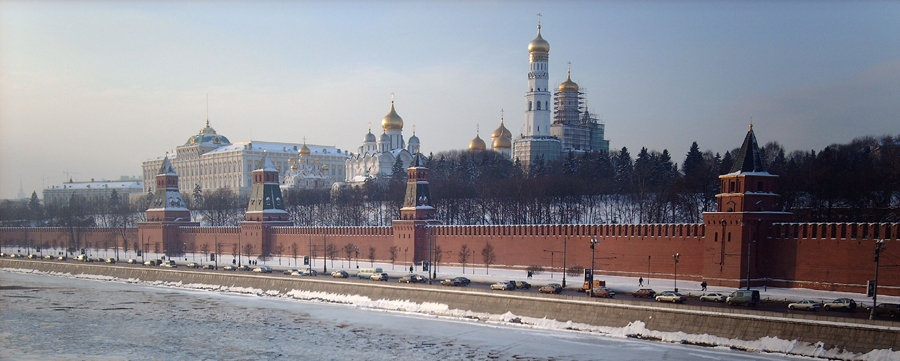|

Lenin's Mausoleum, also known as Lenin's Tomb,is the mausoleum that serves as the current resting place of Vladimir Lenin. His embalmed body has been on public display there since shortly after his death in 1924 (with rare exceptions in wartime). Aleksey Shchusev's diminutive but monumental granite structure incorporates some elements from ancient mausoleums, such as the Step Pyramid and
especially the Tomb of Cyrus the
Great in Pasargadae.
Many
Russians belive, the Jews, those
predominated in a then Soviet government, had such a way expressed thier
gratitude to Lenin for the Jewish emancipation, having drawn an analogy
between Lenin (לנין) and Cyrus (כורש),
who released Jews from the Babylon captivity (גלות
בבל).
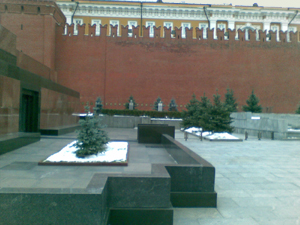
Joseph Stalin's embalmed body shared a spot next to Vladimir Lenin, from the time of his death in 1953 until October 31, 1961, when Stalin was removed
to the Kremlin Wall Necropolis. The row of individual tombs behind the Mausoleum began to acquire its present shape after the end of World War II. Sergei Merkurov created the first five tombs, for the recently deceased Mikhail Kalinin and Andrey Zhdanov, as well as for Yakov Sverdlov, Mikhail Frunze and Felix Dzerzhinsky who perished decades earlier.
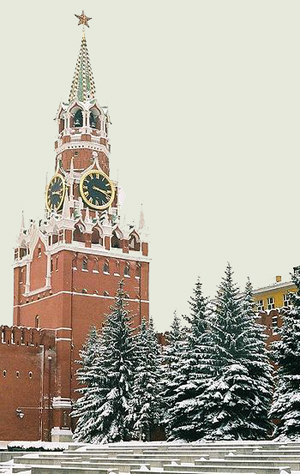
The Spasskaya Tower (Russian: Спасская башня, translated as "Savior Tower") is the main tower with a through-passage on the eastern wall of the Moscow Kremlin, which overlooks the Red Square.
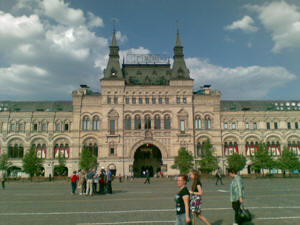
GUM is a large depsrment store in Kitai-gorod of Moscow, facing Red Square.
More→
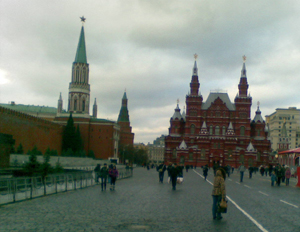
The Troitskaya Tower
and the State Historical Museum.
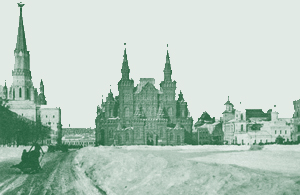
View
from the same point in late 1800s.
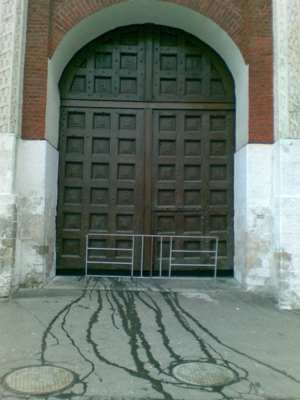
The
gates of the Troitskaya Tower.
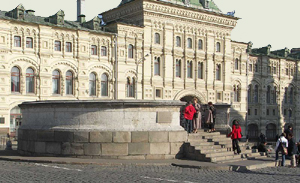
Lobnoye mesto (Russian: Лобное место), also known as the Place of Skulls.
Its name is a Russian translation of the Jewish and Arameic word Gûlgaltâ
(גלגלתא).
|
Red Square
(Krásnaya
plóshchad’)
 Red
Square is the most famous city square in Moscow, and arguably one of the
most famous in the world. The square separates the Kremlin, the former
royal citadel and currently the official residence of the President of
Russia, from a historic merchant quarter known as Kitai-gorod. As major
streets of Moscow radiate from here in all directions, being promoted to
major highways outside the city, Red Square is often considered the
central square of Moscow and of all Russia. Red
Square is the most famous city square in Moscow, and arguably one of the
most famous in the world. The square separates the Kremlin, the former
royal citadel and currently the official residence of the President of
Russia, from a historic merchant quarter known as Kitai-gorod. As major
streets of Moscow radiate from here in all directions, being promoted to
major highways outside the city, Red Square is often considered the
central square of Moscow and of all Russia.
The
Red Square was meant to serve as Moscow's main marketplace. It was also used for various public ceremonies and proclamations, and occasionally as the site of coronation for Russia's czars. The square has been gradually built up since that point and has been used for official ceremonies by all Russian governments since it was established.
The name Red Square derives neither from the colour of the bricks around it (which, in fact, were whitewashed at certain points in history) nor from the link between the colour red and communism. Rather, the name came about because the Russian word красная
(krasnaya) can mean either "red" or "beautiful" (the latter being archaic). This word, with the meaning "beautiful", was originally applied to
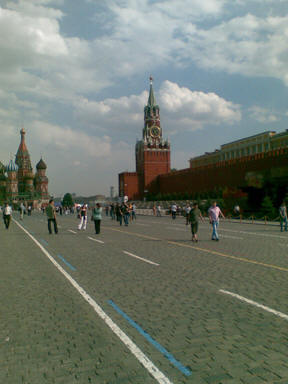 Saint Basil's Cathedral and was subsequently transferred to the nearby square. It is believed that the square acquired its current name (replacing the older Pozhar, or "burnt-out place") in the 17th century. Several ancient Russian towns, such as Suzdal, Yelets, and Pereslavl-Zalessky, have their main square named Krasnaya ploshchad, namesake of Moscow's Red Square. Saint Basil's Cathedral and was subsequently transferred to the nearby square. It is believed that the square acquired its current name (replacing the older Pozhar, or "burnt-out place") in the 17th century. Several ancient Russian towns, such as Suzdal, Yelets, and Pereslavl-Zalessky, have their main square named Krasnaya ploshchad, namesake of Moscow's Red Square.
The east side of the Kremlin triangle, lying adjacent to Red Square and situated between the rivers Moskva and the now-underground Neglinnaya River was deemed the most vulnerable side of the Kremlin to attack, since it was neither protected by the rivers, nor any other natural barriers, as the other sides were. Therefore, the Kremlin wall was built to its highest height on this side, and furthermore, the Italian architects involved in the building of these fortifications convinced Ivan the Great to clear the area outside of the walls in order to create a field of fire for shooting. The relevant decrees were issued in 1493 and 1495. They called for the demolition of all the buildings within 110 sazhens (234 metres) of the wall.
In 1508-1516, the Italian architect Aleviz Fryazin (Novy) arranged for the construction of a moat in front of the eastern wall, which would connect the Moskva and Neglinnaya and be filled in with water from Neglinnaya. This moat, known as the Alevizov moat and having a length of 541 meters, width of 36 meters, and a depth of 9.5–13 m. was lined with limestone and, in 1533, fenced on both sides with low, 4-meter thick cogged brick walls. Three square gates existed on this side of the wall, which in the 17th century, were known as: Konstantino-Eleninsky, Spassky, Nikolsky (owing their names to the icons of Constantine and Helen, the Savior and St. Nicholas which hung over them). The last two are directly opposite the Red Square, while the Konstantino-Elenensky gate was located behind Saint Basil's Cathedral. In the early 19th century, the Arch of Konstantino-Elenensky gate was paved with bricks, but the Spassky Gate was the main front gate of the Kremlin and used for royal entrances. From this gate, wooden and (following the 17th century improvements) stone bridges stretched across the moat. Books were sold on this bridge and stone platforms were built nearby for guns - "raskats". The Tsar Cannon was located on the platform of the Lobnoye mesto.
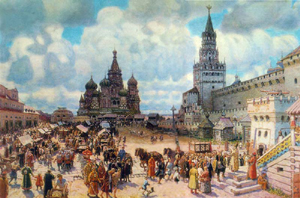 The square was called Veliky Torg (Great market) or simply Torg (Market), then Troitskaya by name a small Troitskaya (Trinity) Church, burnt down in the great fire during the Tatar invasion in 1571. After that, the square held the title Pozhar. It was not until 1661-62, when it was first mentioned as by its contemporary Krasnaya - "Red" name.
The square was called Veliky Torg (Great market) or simply Torg (Market), then Troitskaya by name a small Troitskaya (Trinity) Church, burnt down in the great fire during the Tatar invasion in 1571. After that, the square held the title Pozhar. It was not until 1661-62, when it was first mentioned as by its contemporary Krasnaya - "Red" name.
Red Square was the landing stage and trade center for Moscow. Ivan the Great decreed that trade should only be conducted from person to person, but in time, these rules were relaxed and permanent market buildings began appearing on the square. After a fire in 1547, Ivan the Terrible reorganized the lines of wooden shops on the eastern side into market lines. The streets Ilyinka and Varvarka were divided into the Upper lines (now GUM department store), Middle lines and Bottom lines, although Bottom Lines were already in Zaryadye).
After a few years, the Cathedral of Intercession of the Virgin, commonly known as Saint Basil's Cathedral, was built on the moat. This was the first building which gave the square its present-day characteristic silhouette (on the Kremlin towers but has not yet been built pyramidal roofs). In 1595, wooden market lines were replaced with stone. By that time, a brick platform for the proclamation of the tsar's edicts, known as Lobnoye Mesto had also has been constructed.
The Red Square was considered a sacred place. Various festive processions were held there, and during Palm Sunday the famous "procession on a donkey" was arranged, in which the patriarch, sitting on a donkey, accompanied by the tsar and the people went out of Saint Basil's Cathedral in the Kremlin.
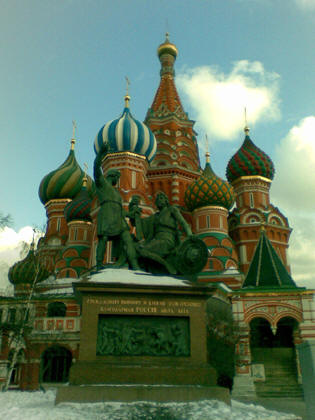 During the expulsion of Poles from Moscow in 1612, Prince Dmitry Pozharsky entered the Kremlin through the square. In memory of this event, he built the Kazan Cathedral - in honour of the Kazan Icon of the Mother of God, followed his army in a campaign. During the expulsion of Poles from Moscow in 1612, Prince Dmitry Pozharsky entered the Kremlin through the square. In memory of this event, he built the Kazan Cathedral - in honour of the Kazan Icon of the Mother of God, followed his army in a campaign.
Zemsky prikazAt the same time (1624–1625) Spasskaya tower received contemporary tent roofs. This was done on the proposal and the draught of Englishman Christopher Galloway, who was summoned to the device to the new tower's clock (clock watch it there with the 1585) and suggested that to arrange over clock the tent roof. In the mid-century on the top of the tower was it is set up gilded double-headed eagle. After this, the square became known as Krasnaya - «beautiful».
In the late 17'th century the square was cleared of all wooden structures (1679–1680). Then all Kremlin towers received tent roofs, except Nikolskaya. One tent was erected, even on the wall above the Red Square (the so-called Tsarskaya Tower, intended, that the tsar could watch this space for the various ceremonies in the square). There were also are constructed tents roofs at Voskrerensky (Iberian) gates, arranged in the wall of Kitai-gorod. These were the fortified gates at Voskresensky Bridge over the River Neglinnaya.
In 1697 and 1699, gates were built on both sides of Voskresensky ontwo large stone buildings: the Mint and Zemsky prikaz (department in charge of urban and police matters). Zemsky prikaz, then, was known as the Main Pharmacy (on-site new Historical Museum). In the building of Zemsky prikaz in 1755 was organised by first Russian University. At the same time in the Alevizov moat, where there was no water, a state Pharmacy's garden (where the growing of medicinal plants) was
arranged.
In 1702, the first public theater in Russia was built near the Nikolsky
gate; It stood until 1737, when it was destroyed in a fire.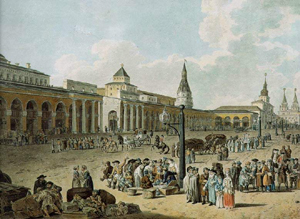
In the 1730s, a new mint building, called the Gubernskoye pravlenie (Provincial
Board), was built in front of the old one
During her reign, Catherine the Great decided to make improvements to the
square. In 1786, second floors were the stone market lines. This line was built on the opposite side of the square - at moat between the Spasskaya and Nikolskaya
towers. Then architect Matvey Kazakov built (in the old forms) the new Lobnoye mesto of hewn
stone, slightly west of the place where it was before.
In 1804, at the request of merchants, the square was paved in stone. In 1806 Nikolskaya Tower was reconstructed in the Gothic
style, and has received a tent roof. The new phase of improvement of the square began after the Napoleonic invasion and fire in 1812. The moat was filled in 1813 and in its
place, rows of trees were planted. Market Line along the moat, dilapidated after the
fire, had been demolished, and on the eastern side Joseph Bové constructed new building of lines in Empire
style. In 1818 the Monument to Minin and Pozharsky, was erected, symbolising the rise in patriotic consciousness during the
war.
I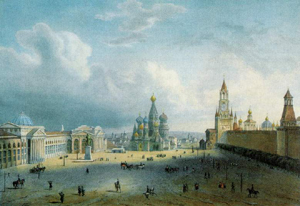 n 1874, the historic building of Zemsky prikaz was demolished. In its place was built the Imperial Historical Museum in pseudo-Russian style. After Bové's lines were demolished, new large buildings were erected between 1888-1893 in the pseudo-Russian style: upper lines (Gum department store) and middle lines. The upper lines was intended for retail sale and were in fact the first department store in Moscow; middle lines intended for the wholesale trade. At the same time (in 1892) the square was illuminated by electric lanterns. In 1909, a tram appeared on the square for the first time. n 1874, the historic building of Zemsky prikaz was demolished. In its place was built the Imperial Historical Museum in pseudo-Russian style. After Bové's lines were demolished, new large buildings were erected between 1888-1893 in the pseudo-Russian style: upper lines (Gum department store) and middle lines. The upper lines was intended for retail sale and were in fact the first department store in Moscow; middle lines intended for the wholesale trade. At the same time (in 1892) the square was illuminated by electric lanterns. In 1909, a tram appeared on the square for the first time.
During the Soviet era, Red Square maintained its significance, becoming a focal point for the new state. Besides being the official address of the Soviet government, it was renowned as a showcase for military parades. Kazan Cathedral and Iverskaya Chapel with the Resurrection Gates were demolished to make room for heavy military vehicles driving through the square (both were later rebuilt after the fall of the Soviet Union). There were plans to demolish Moscow's most recognized building, Saint Basil's Cathedral, as well. The legend is that Lazar Kaganovich, Stalin's associate and director of the Moscow reconstruction plan, prepared a special model of Red Square, in which the cathedral could be removed, and brought it to Stalin to show how the cathedral was an obstacle for parades and traffic. But when he jerked the cathedral out of the square, Stalin objected with his famous quote: "Lazar! Put it back!".
Military parade marking the sixty-third anniversary of Victory in the Great Patriotic WarTwo of the most significant military parades on Red Square were the one in 1941, when the city was besieged by Germans and troops were leaving Red Square straight to the front lines, and the Victory Parade in 1945, when the banners of defeated Nazi armies were thrown at the foot of Lenin's Mausoleum. The Soviet Union held very many parades in Red Square for May Day, Victory Day, and the October Revolution which consisted of propaganda, flags, a labor demonstration, and a troops march and show-off of tanks and missles. On Victory Day in 1945, 1965, 1985, and 1990 there were military marches and parades as
well.
On May 28, 1987, a German pilot named Mathias Rust landed a light aircraft on St Basil's descent next to Red Square.
In 1990, the Kremlin and Red Square were among the very first sites in the USSR added to UNESCO's World Heritage List.
In recent years, Red Square has served as a venue for high-profile concerts. Shakira, Scorpions, Paul McCartney, t.A.T.u., Roger Waters, Red Hot Chili Peppers, Alyonka & Diana Larionov, and many other celebrities performed there. For the New Year 2006, 2007 and 2008 celebrations, a skating rink was set up on Red Square. Paul McCartney's performance there was a historic moment for many, as The Beatles were banned in the Soviet Union, preventing any live performances there of any of The Beatles; the Soviet Union also banned the sales of Beatles records, and this was the first time that a Beatle performed in Russia.
In January 2008, Russia announced that they would resume parading military vehicles through Red
Square, although recent restoration of Iverski Gate complicated this, by closing one of existing passages along Historical Museum for the heavy vehicles.
 See
the location of the Moscow free restrooms on the map. See
the location of the Moscow free restrooms on the map.
See
also:

Moscow in pictures
 Moscow
Moscow

How to use Moscow Metro
 Moscow ground public transport
Moscow ground public transport
 Red Square
Red Square
 GUM
GUM
|
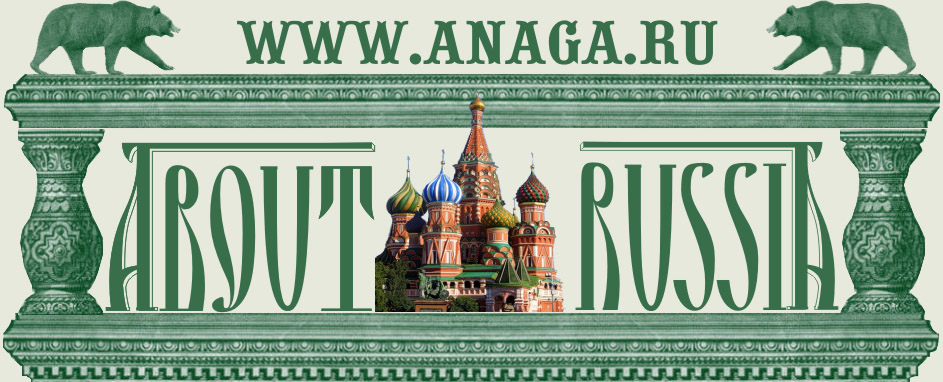








 Red
Square is the most famous city square in Moscow, and arguably one of the
most famous in the world. The square separates the Kremlin, the former
royal citadel and currently the official residence of the President of
Russia, from a historic merchant quarter known as Kitai-gorod. As major
streets of Moscow radiate from here in all directions, being promoted to
major highways outside the city, Red Square is often considered the
central square of Moscow and of all Russia.
Red
Square is the most famous city square in Moscow, and arguably one of the
most famous in the world. The square separates the Kremlin, the former
royal citadel and currently the official residence of the President of
Russia, from a historic merchant quarter known as Kitai-gorod. As major
streets of Moscow radiate from here in all directions, being promoted to
major highways outside the city, Red Square is often considered the
central square of Moscow and of all Russia.
 Saint Basil's Cathedral and was subsequently transferred to the nearby square. It is believed that the square acquired its current name (replacing the older Pozhar, or "burnt-out place") in the 17th century. Several ancient Russian towns, such as Suzdal, Yelets, and Pereslavl-Zalessky, have their main square named Krasnaya ploshchad, namesake of Moscow's Red Square.
Saint Basil's Cathedral and was subsequently transferred to the nearby square. It is believed that the square acquired its current name (replacing the older Pozhar, or "burnt-out place") in the 17th century. Several ancient Russian towns, such as Suzdal, Yelets, and Pereslavl-Zalessky, have their main square named Krasnaya ploshchad, namesake of Moscow's Red Square. The square was called Veliky Torg (Great market) or simply Torg (Market), then Troitskaya by name a small Troitskaya (Trinity) Church, burnt down in the great fire during the Tatar invasion in 1571. After that, the square held the title Pozhar. It was not until 1661-62, when it was first mentioned as by its contemporary Krasnaya - "Red" name.
The square was called Veliky Torg (Great market) or simply Torg (Market), then Troitskaya by name a small Troitskaya (Trinity) Church, burnt down in the great fire during the Tatar invasion in 1571. After that, the square held the title Pozhar. It was not until 1661-62, when it was first mentioned as by its contemporary Krasnaya - "Red" name. During the expulsion of Poles from Moscow in 1612, Prince Dmitry Pozharsky entered the Kremlin through the square. In memory of this event, he built the Kazan Cathedral - in honour of the Kazan Icon of the Mother of God, followed his army in a campaign.
During the expulsion of Poles from Moscow in 1612, Prince Dmitry Pozharsky entered the Kremlin through the square. In memory of this event, he built the Kazan Cathedral - in honour of the Kazan Icon of the Mother of God, followed his army in a campaign.
 n 1874, the historic building of Zemsky prikaz was demolished. In its place was built the Imperial Historical Museum in pseudo-Russian style. After Bové's lines were demolished, new large buildings were erected between 1888-1893 in the pseudo-Russian style: upper lines (Gum department store) and middle lines. The upper lines was intended for retail sale and were in fact the first department store in Moscow; middle lines intended for the wholesale trade. At the same time (in 1892) the square was illuminated by electric lanterns. In 1909, a tram appeared on the square for the first time.
n 1874, the historic building of Zemsky prikaz was demolished. In its place was built the Imperial Historical Museum in pseudo-Russian style. After Bové's lines were demolished, new large buildings were erected between 1888-1893 in the pseudo-Russian style: upper lines (Gum department store) and middle lines. The upper lines was intended for retail sale and were in fact the first department store in Moscow; middle lines intended for the wholesale trade. At the same time (in 1892) the square was illuminated by electric lanterns. In 1909, a tram appeared on the square for the first time.